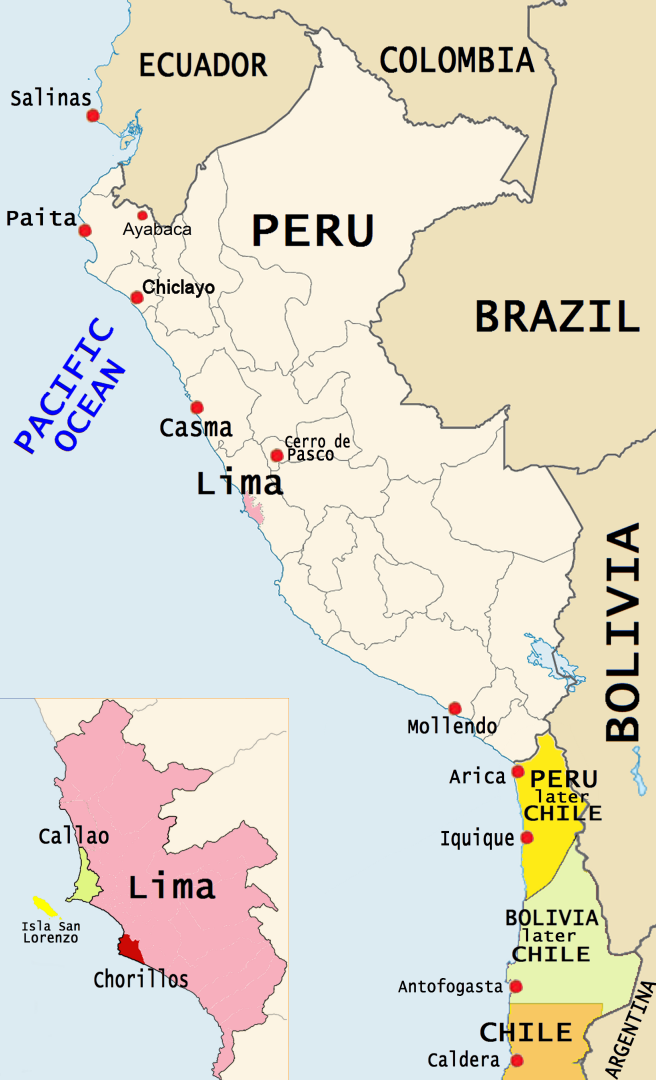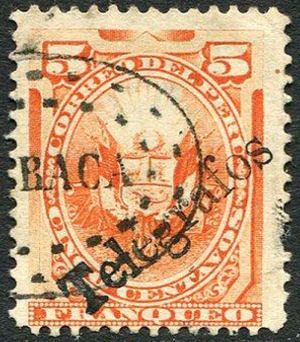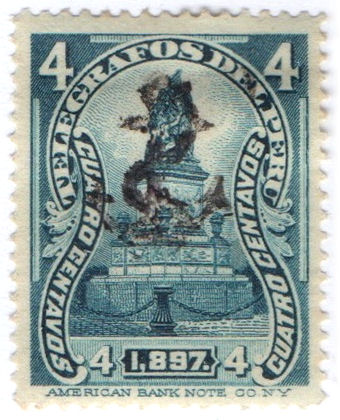| Up a level | ||||||||||
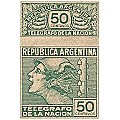 |
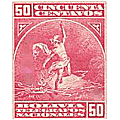 |
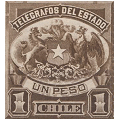 |
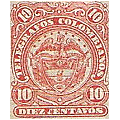 |
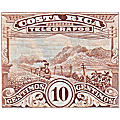 |
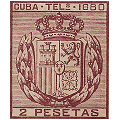 |
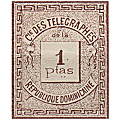 |
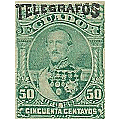 |
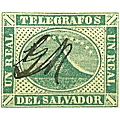 |
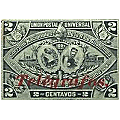 |
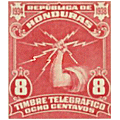 |
| Argentina | Bolivia | Chile | Colombia | Costa Rica | Cuba | Dominican Rep. | Ecuador | El Salvador | Guatemala | Honduras |
| Up a level | ||||||||||
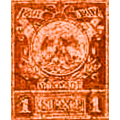 |
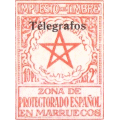 |
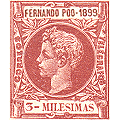 |
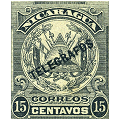 |
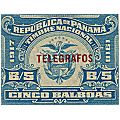 |
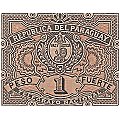 |
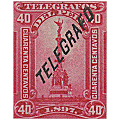 |
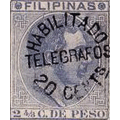 |
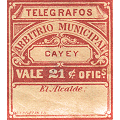 |
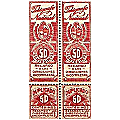 |
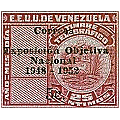 |
| Mexico | Morocco | Guinea | Nicaragua | Panama | Paraguay | Peru | Philippines | Puerto Rico | Uruguay | Venezuela |
Contributors: |
I have made an addition and used 'RH' (Revised Hiscocks) numbers to |
Peru.
Steve Hiscocks wrote:
The stamps used for telegraphic purposes in Peru are themselves fairly straight-forward with two series of specifically telegraph stamps separated
by a series of overprinted postage stamps and a pair of overprinted postage due stamps. The use of postage due stamps is unusual. There is some
uncertainty however over the 'overprints' of 'PERU' and the name of a town in capitals on two lines commonly found on all but (in my experience) the
first (1876-96) series. Walter Morley, in a series of notes in his journal during 1901, regards these as town overprints applied before sale and lists
dozens of them on various values in various colours. An examination of those that have come my way suggest that these were not overprints but
were the standard form of cancellation from around 1896 onwards. All those I have found without such a cancellation have been clearly mint and
possessed of their original gum while all those bearing the PERU / Town cancellations have no gum and no sign of other cancellation. Subject to
correction I therefore conclude that the standard form of cancellation after about 1896 was a neat hand stamp of PERU / Name of town in black,
blue-black, purple, blue, green, magenta, or red, fairly centrally placed, although at random orientation, on each stamp. Those reported with
additions from my own collection, are listed below. No doubt there are many more to be added.
| CHANCAY (purple) | CONCEPCION (black) | HUARAL (purple) | PAITA (black, blue-black) | TARMA (blue-black, red, blue) |
| CHIMBOTE (blue-black) | FERRENAFE (blue-black) | HUARMEY (blue-black, black) | PAMPAS (magenta) | TRUJILLO(?) (magenta) |
| CHIMBQUE (purple) | FERRO do RAS...(?) (blue-black) | LAMBAYEQUE (black) | SALAVERRY (blue-black) | VILLALTA (blue-black) |
| CHINCHA (magenta) | HUANUCO (green) | LIMA (black, purple, magenta) | SAN PEDRO (black) | YCA (ICA?) (black, blue-black, green, purple) |
Additionally, Casma (Purple) and Chiclayo (blue, see near bottom).
Can anyone add more to this list ?
My note:
I have added images of telegraphic items before the telegraph stamps were issued,
as well as some fake overprints that have come to light.
The catalogue of John Barefoot, illustrates a couple of stamps having cancels not on the list above. These are:
PERU / PISCO (blue-black?) and, interestingly, LIMA / NORTE (purple), on this, 'LIMA' is smaller than usual.
At times (or locations ?) when special Telegraph stamps were not in use, payments for Telegraph services appear to have been made with normal postage stamps that received the 'Bullseye' cancel as in Costa Rica.
Many of these same stamps were later overprinted for telegraphic use, though with a new special cancel.
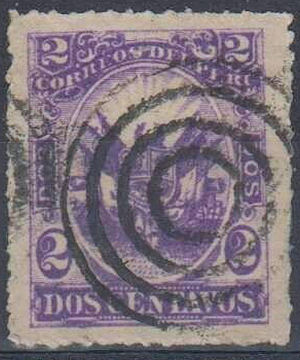 |
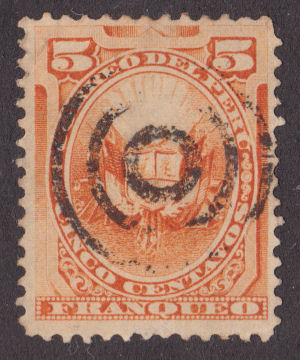 |
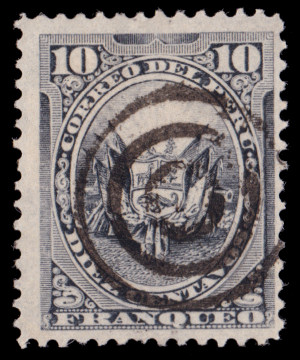 |
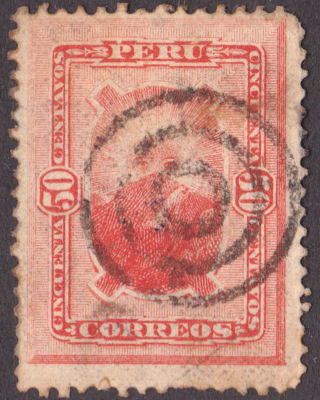 |
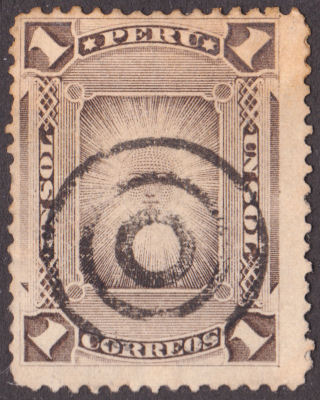 |
| 1874 - 2c courtesy of Victor Gugliano | 1886 - 5c | 1886 - 10c | 1886 - 50c | 1886 - 1s |
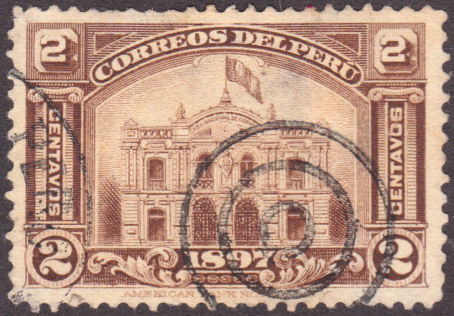 |
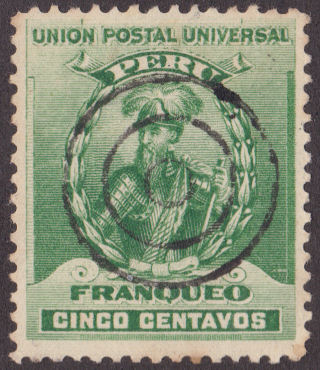 |
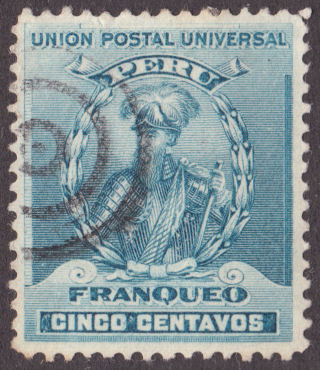 |
| 1897 - 2c (Posts & Telegraph building) | 1897 - 5c | 1899 - 5c |
Note: This type of cancel is often seen on fake Pacific Steam Navigation Company (PSNC) stamps, it is not known on genuine examples.
For an overview of the PSNC reprints and fakes, see this writeup.
Unlike many Hispanic countries, Peru did not create "Correos y Telegrafos" issues.
1876 Engraved by the American Bank Note Co. White wove paper. No watermark. Perf. 12.
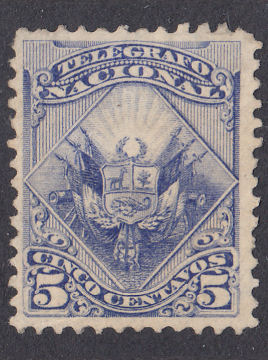 |
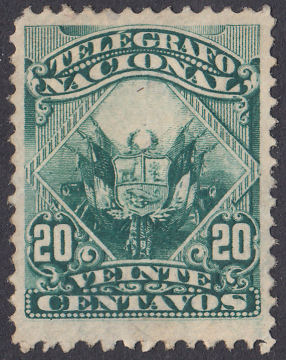 |
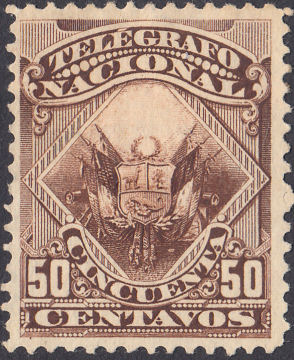 |
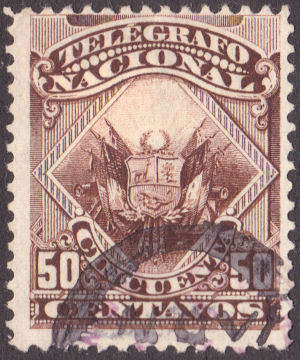 |
| H1 | H2 | H3 | H3 - used with rather odd cancel. |
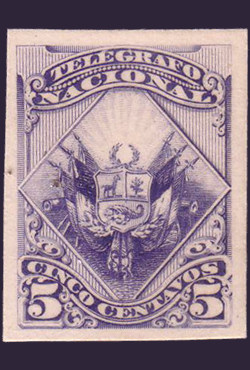 |
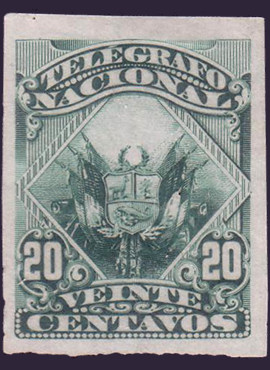 |
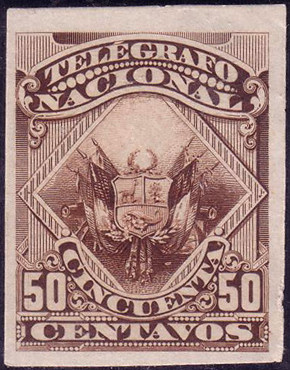 |
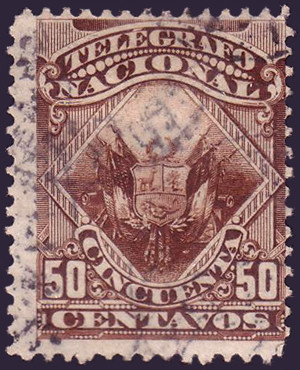 |
| H1 - Proof on thick paper. | H2 - Proof ? | H3 - Proof ? | H3 - used |
| Images courtesy of Rolf Lamprecht. | |||
1896-1898 Postage stamps of 1866 (10c & 20c) and 1874-95 overprinted 'TELEGRAFOS' as type 4.
White wove paper. No watermark. Perf. 12.
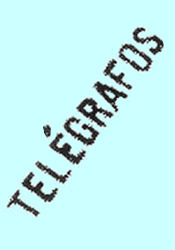 |
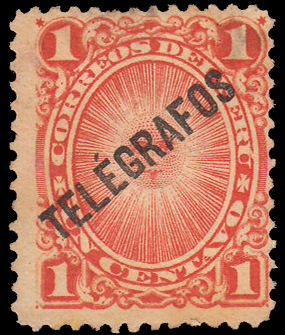 |
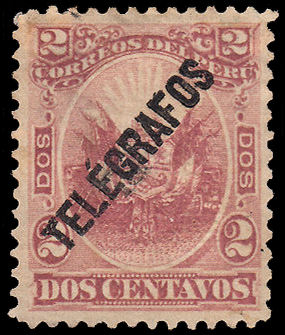 |
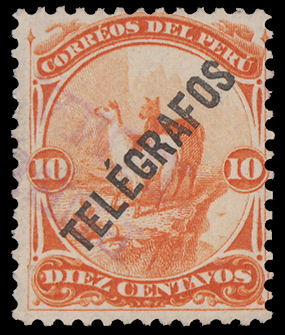 |
| Type 4 | H4 | H5 | H6 |
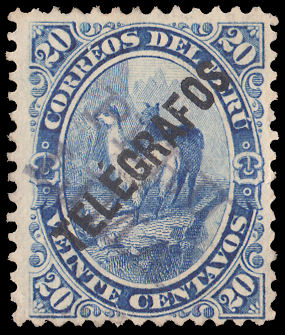 |
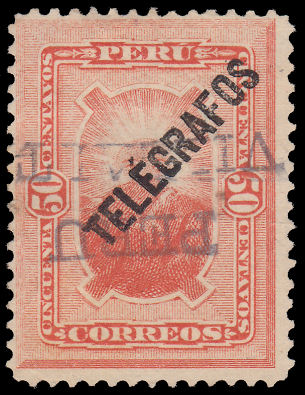 |
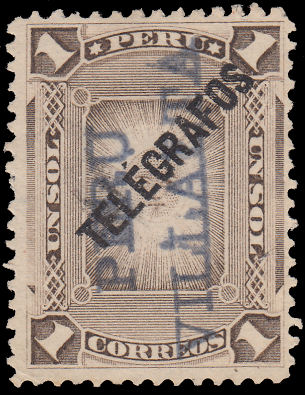 |
| H7 | H8 | H9 |
| Hisc. | Type. | Description | Mint | Used |
|---|---|---|---|---|
| H4 | 5, 4 | 1c vermilion (SG24) | 3.50 | 3.00 |
| H5 | 6, 4 | 2c lake (SG25) | 4.00 | 2.50 |
| H6 | 7, 4 | 10c orange (SG18) | 3.00 | 2.00 |
| H7 | 8, 4 | 20c blue (SG282) | 10.00 | 7.50 |
| H8 | 9, 4 | 50c dull vermilion (SG283) | 20.00 | 10.00 |
| H9 | 10, 4 | 1s grey-brown (SG284) | 40.00 | 25.00 |
| H9a | overprint double | 250.00 | - |
The un-overprinted stamps of this series included extra values and in some cases the same values in different colours. These comprise:
1c dull violet(later vermilion), 2c green(later dark ultramarine), 5c orange, 10c slate, 20c red-brown, 50c red and 1s brown.
The top two of these (without overprint), I have seen used with the bullseye cancel that in some places at least (i.e. Costa Rica) is associated with Telegraphic usage.
Most of the Peruvian stamps that I have seen with a bullseye cancel have been 5c stamps (3 different ones) which makes it rather strange that no 5c stamps were overprinted.
The 10c orange can be darkened by sulpher in the atmosphere.
Hiscocks added the following note:
| Note. The postally used version of the 2c value on which No. 5 is based is reddish violet. The lake variety was not issued without overprint. |
1896? Postage due stamps of 1874-9 (SG D31 and D34) overprinted as before.
White wove paper. No watermark. Perf. 12.
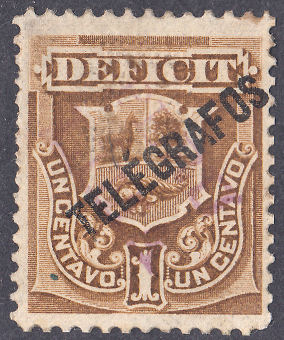 |
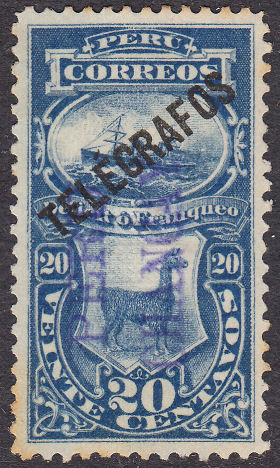 |
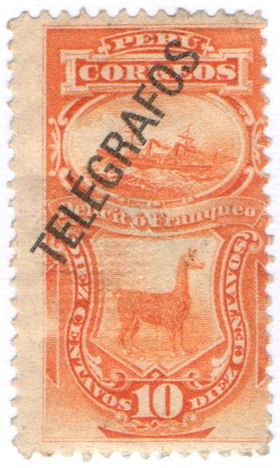 |
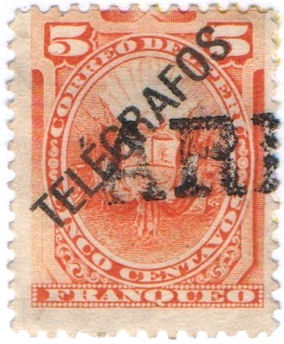 |
| Type 11 (H10) | Type 12 (H11) | Forged Overprints - Wider letters, particularly the 'A'. The 10c is an 1874 postage due stamp. The 5c is an 1886 postage stamp. Images courtesy of Paul & Les Bottomley. |
|
Forged Overprints The ones illustrated are a bit blatant since the genuine overprint is unknown on these stamps.
The same collection has this overprint also on H8, H9 and H10, so be very careful before parting with a lot of money.
This forged overprint has wider, slimmer letters. The 'A' is particularly different.
Another give-away on the 5c is the postal cancellation.
| Hisc. | Type. | Description | Mint | Used |
|---|---|---|---|---|
| H10 | 11, 4 | 1c light brown (SG D31) | 5.00 | 4.50 |
| H11 | 12, 4 | 20c blue (SG D34) | 15.00 | 7.50 |
1897 New designs. Engraved by the American Bank Note Co. on white wove paper. No watermark. Perf. 12.
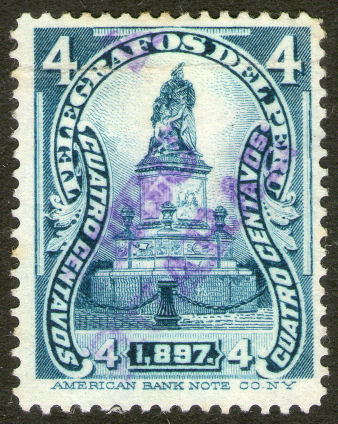 |
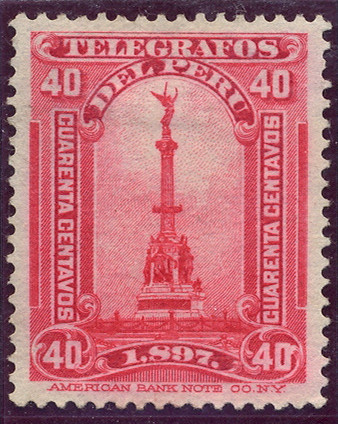 |
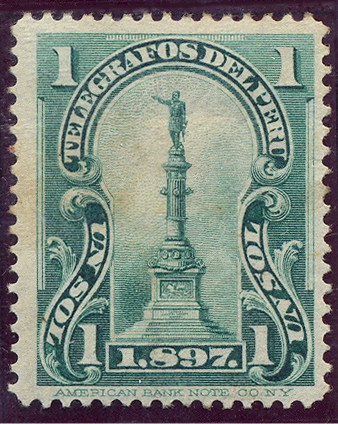 |
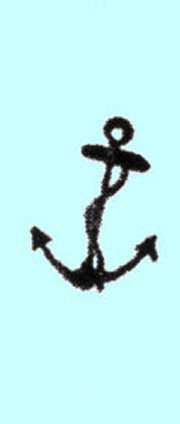 |
| Type 13 - H12 | Type 14 - H13 - from RL | Type 15 - H14 - from RL | Type 16, but read note below. |
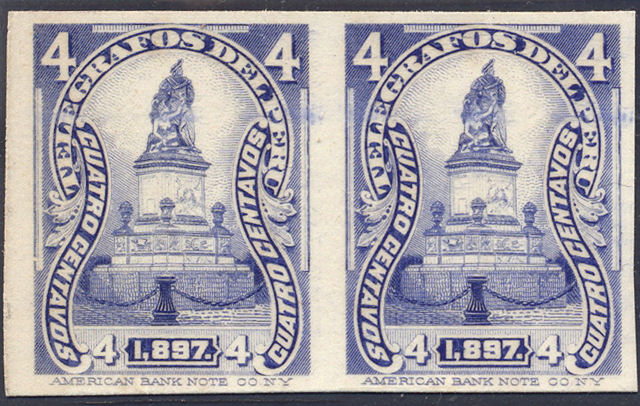
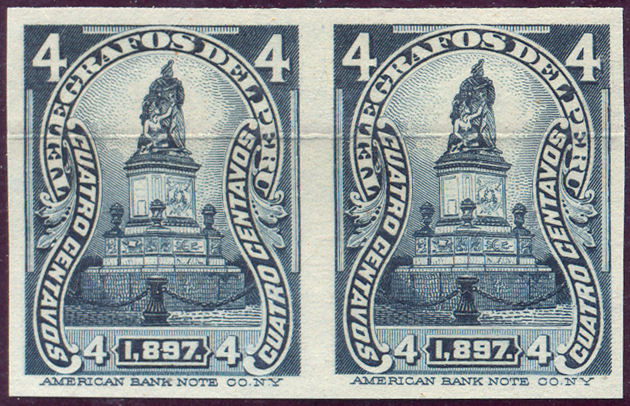
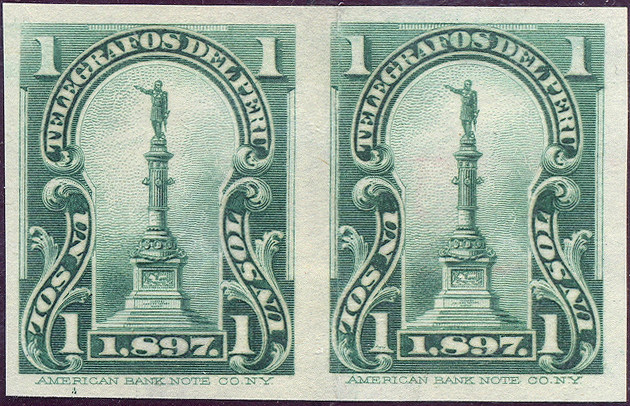
H12b pairs and H14b pair - from RL.
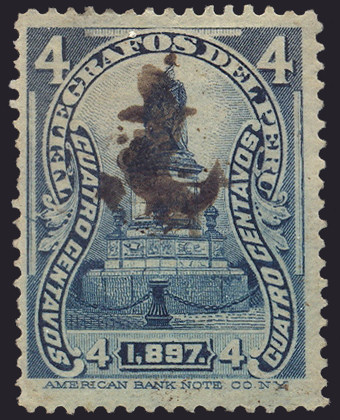
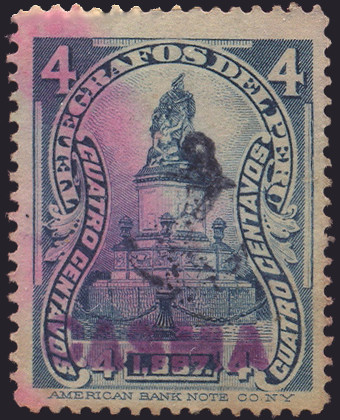
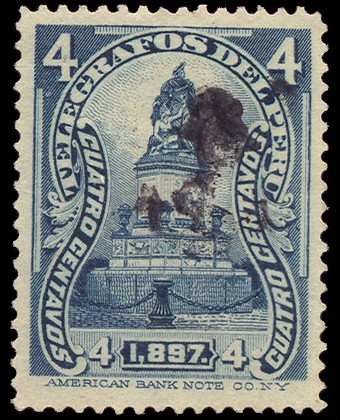
Three more examples from RL. The one with the Casma cancel is interesting, the anchor suggests a naval connection, but John Barefoot suggests
that the anchor may indicate use of the international (submarine) cable service.
Casma is on the coast.
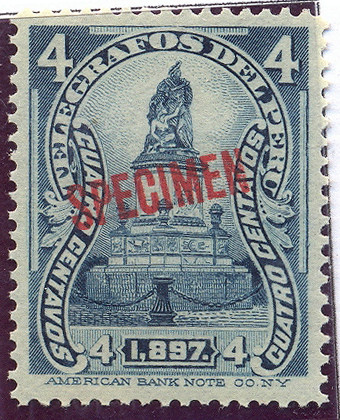
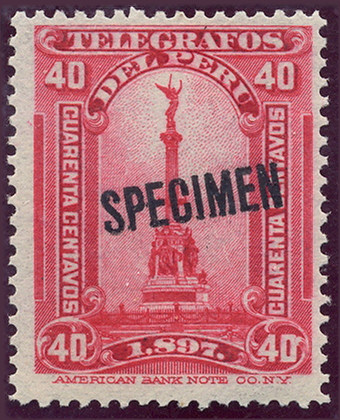
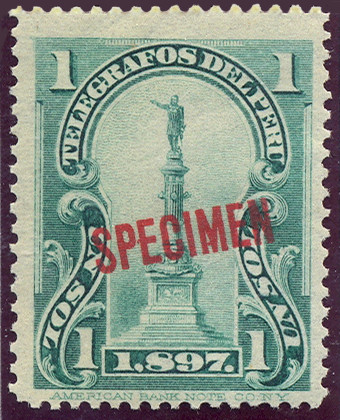
Three Specimens from RL.
1904 As above but overprinted 'TELEGRAFO' as type 17 in black.
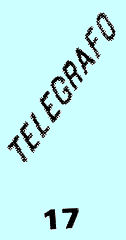 |
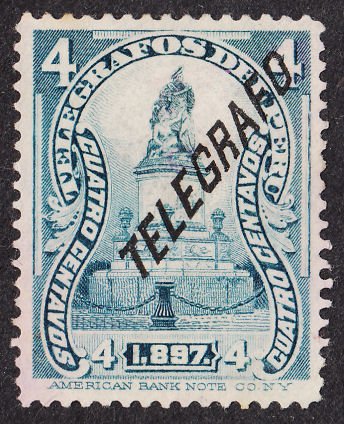 |
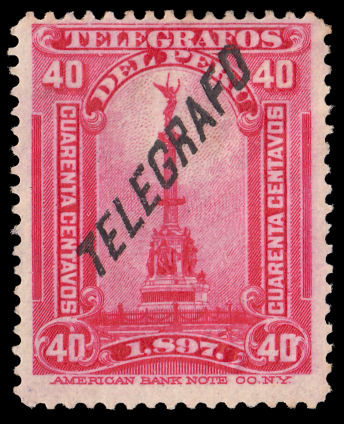 |
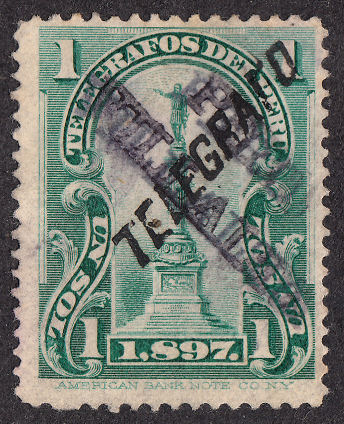 |
| Overprint 17 | 4c - H15 | 40c - H16 | 1s - H17 |
| Hisc. | Type. | Description | Mint | Used |
|---|---|---|---|---|
| H15 | 13, 17 | 4c dark blue | 4.50 | 3.00 |
| H16 | 14, 17 | 40c rose | 3.50 | 2.50 |
| H17 | 15, 17 | 1s green | 100.00 | 70.00 |
Chiclayo cancels.
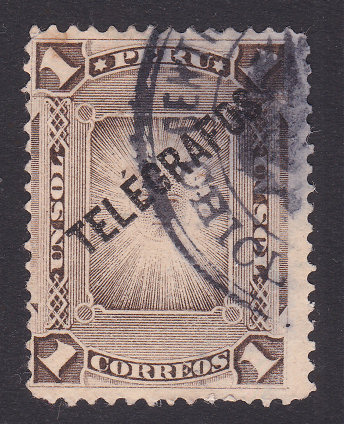 |
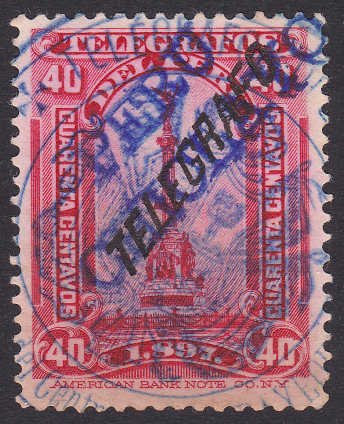 |
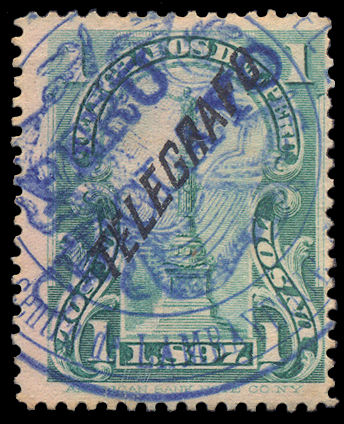 |
| H9 with black ornate circular cancel. | H16 with blue normal plus ornate cancels. | H17 with blue normal plus ornate cancels, courtesy of Rolf Lamprecht. |
These are the only ones I have seen cancelled in Chiclayo, which considering that it is now the fourth largest city in Peru, is perhaps surprising.
Chiclayo, the 'City of Friendship' became a city in 1835. It is 13km inland from the coast in the north of the country.
If the ornate cancel is normal for Chiclayo, perhaps they have all been 'snapped up' by local collectors.
No further Telegraph stamps were issued, and it appears that postage stamps were again used, at least some being punched.
A punched 1 Sol postage stamp of 1924-6.
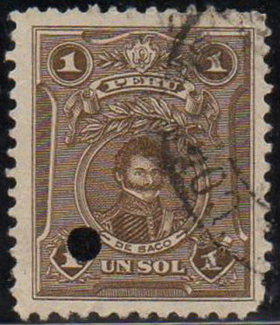
Image courtesy of Jose Villa Flores (Viflor on eBay).
Click image for listing.
A State Telegram of 1913.
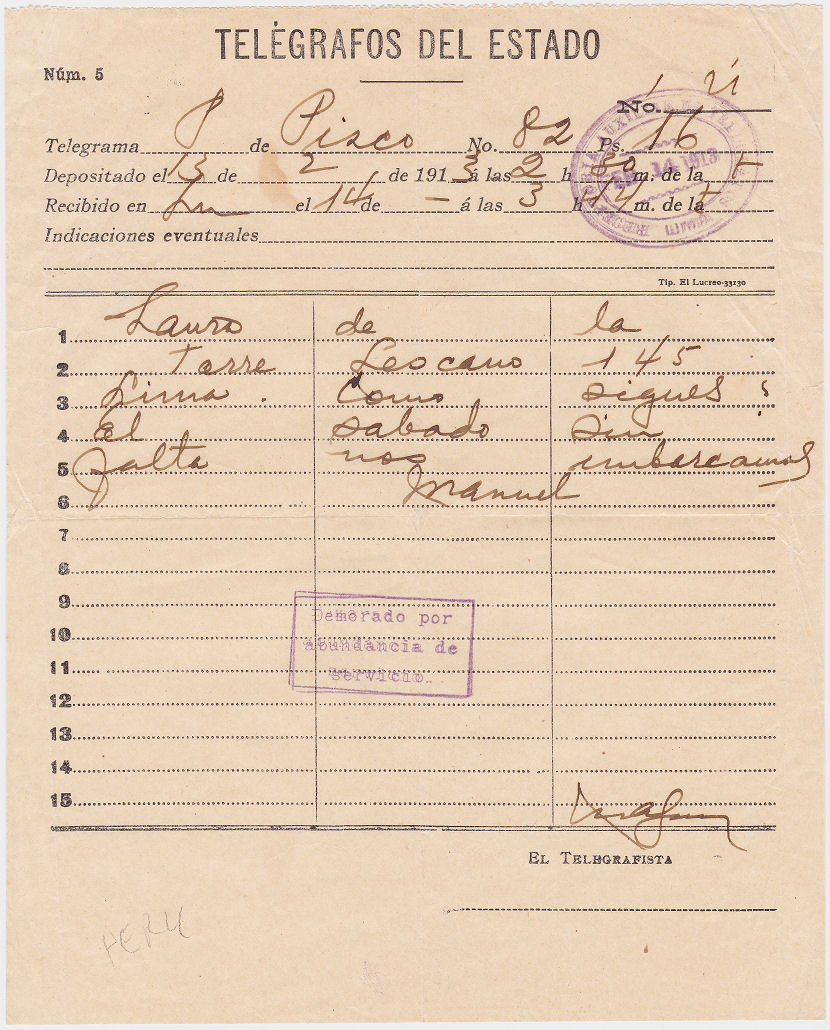
A Central & South American Telegraph Co. telegraph receipt of 1917.
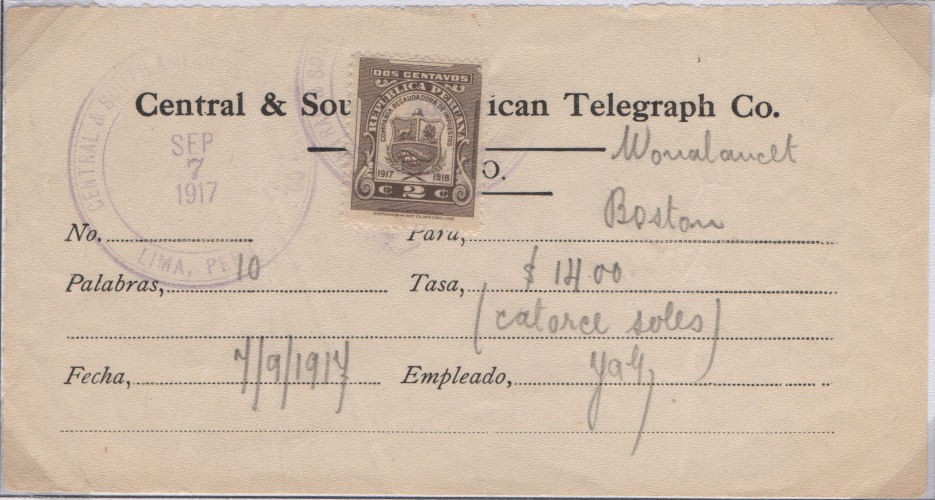
10 words to Boston for $14. Courtesy of Les Bottomley.
More stamp images can be seen at stampsperu.com.
